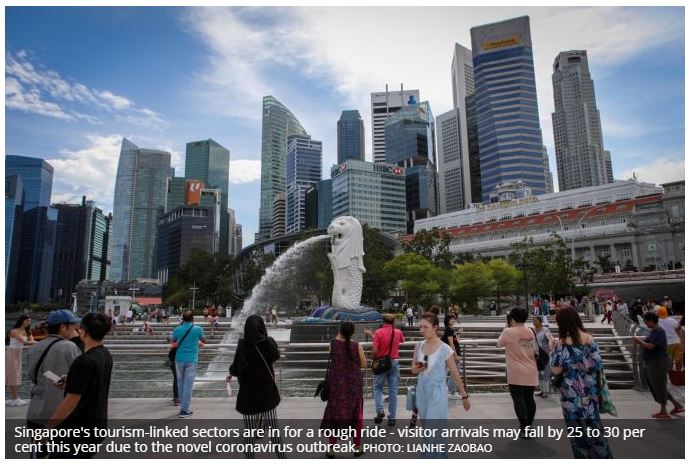Singapore: Outbreak may slash visitor arrivals 25-30%; STB not counting on V-shaped recovery
SINGAPORE’S tourism-linked sectors are in for a rough ride – visitor arrivals may fall by 25 to 30 per cent this year due to the novel coronavirus outbreak.
The decline will come after four straight years of growth in arrivals and receipts, said the Singapore Tourism Board (STB) at its annual year-in-review on Tuesday.
While hard to estimate, the decline in receipts is likely to be “roughly in line” with the decline in arrivals, said STB chief executive Keith Tan.
The situation in 2020 will be “at least as severe as Sars, and probably worse”, he noted. Arrivals fell 19 per cent in the 2003 Sars crisis but had a V-shaped recovery, rising year-on-year about eight months after Singapore was declared Sars-free.
“This time around, I’m not counting on a V-shaped recovery,” Mr Tan told media. But when the rebound comes, the aim is for a strong one, with a task force to be formed for this.
Singaporeans and residents “play an important part in recovery”, said Sentosa Development Corporation chief executive Quek Swee Kuan, who urged locals to consume tourism, hospitality, and lifestyle services here.
International visitor arrivals rose 3.3 per cent year-on-year to 19.1 million in 2019, near the top of the 18.7 million to 19.2 million forecast range.
Preliminary estimates put tourism receipts at S$27.1 billion, up 0.5 per cent year-on-year but missing the forecast of S$27.3 billion to S$27.9 billion. For the first nine months of the year, receipts fell for accommodation (-7 per cent), food and beverage (-5 per cent), and sightseeing, entertainment, and gaming (-2 per cent), compared to the year-ago period.
However, shopping receipts were up 3 per cent, and other tourism receipts rose 4 per cent, including higher airfare revenue with more visitor arrivals via local-based carriers.
Business travel and meetings, incentive travel, conventions and exhibitions (BTMICE) had a weaker 2019.
For the first nine months, BTMICE tourism receipts – excluding sightseeing, entertainment, and gaming – were down 7 per cent from the year-ago period at S$3.2 billion.
STB attributed this to fewer BTMICE arrivals, which fell 8 per cent to 1.8 million, and macroeconomic uncertainties affecting spending. The sector tends to do worse in odd years.
Before the virus hit, the sector was “ready for a good year” in 2020, said Singapore Association of Convention & Exhibition Organisers and Suppliers president Aloysius Arlando.
Still, most events are being postponed rather than cancelled. The association is working with organisers and venues to manage the bunching that may happen in the year’s second half, with a strong events pipeline for H2 and beyond, he added.
In 2019, the hotel industry saw growth across all indicators. Total gazetted hotel room revenue rose 5.5 per cent to S$4.2 billion, with the average occupancy rate up at 87.1 per cent, from 86 per cent previously.
Average room rates rose to S$221 from S$218, and revenue per available room hit S$193, up from S$188.
Similar to the Sars crisis – when the industry did not retrench anyone – hotels will take this time to retrain workers and carry out repairs and renovations, said Singapore Hotel Association president Kwee Wei-Lin.
At Royal Plaza on Scotts, with employees clearing two-thirds of their leave in the first half of 2020 and a staycation promotion for residents, the hope is that revenue loss will not exceed 30 per cent for the year.
In the cruise industry, passenger throughput fell 2.5 per cent to 1.8 million, largely due to Royal Caribbean International’s Voyager of the Seas being dry-docked for over a month for refurbishment. Foreign cruise throughput grew 3.5 per cent, while ship calls rose 3.2 per cent to 414.
China remained the top source market in 2019, accounting for 3.6 million visitors – about a fifth of all visitors – and S$3.2 billion in receipts excluding sightseeing, entertainment, and gaming. It was among 11 of Singapore’s top 15 source markets to see arrival numbers grow, and one of nine where arrivals hit new highs.
But the novel coronavirus has meant an estimated loss of 18,000 to 20,000 international visitor arrivals each day. Most are from China, given travel restrictions on both sides, but arrivals from other key markets are also expected to fall due to lower travel confidence. There is a further danger of the virus hitting regional supply chains and growth, further dampening travel demand.
Some attractions have seen visitors fall by up to 60 per cent in the last 10 to 12 days, said Association of Singapore Attractions executive committee member Kevin Cheong. At Sentosa, businesses have seen visitors and sales decline by 20 to 50 per cent since early February, said Mr Quek.
He hopes to attract more locals instead. For a start, island admission will be waived for the upcoming school holidays from March 14 to 22.
Asked about the risk of countries issuing travel advisories on Singapore, Mr Tan said the STB sees “no reason” to do so and is working with the Ministry of Foreign Affairs on this.
A Tourism Recovery Action Task Force comprising public and private sector leaders will come up with strategies and plans for recovery. They will identify opportunities arising from the crisis, take measures to instil confidence in tourism establishments here, and co-create and initiate recovery plans.
The STB highlighted new and rejuvenated offerings such as the Magical Shores attraction at Siloso Beach, progress on projects such as the Mandai Nature Precinct and the Sentosa-Brani masterplan, and a pipeline of BTMICE events in 2020 and beyond, including gamescom asia 2020.
For now, affected sectors aim to control costs and keep workers, opting for shorter work weeks, redeployment, or leave-clearing over retrenchment. “We want to be prepared for the recovery phase,” said National Association of Travel Agents Singapore secretary-general Charles Tan.
Source: https://www.businesstimes.com.sg/government-economy/outbreak-may-slash-visitor-arrivals-25-30-stb-not-counting-on-v-shaped-recovery


 English
English




